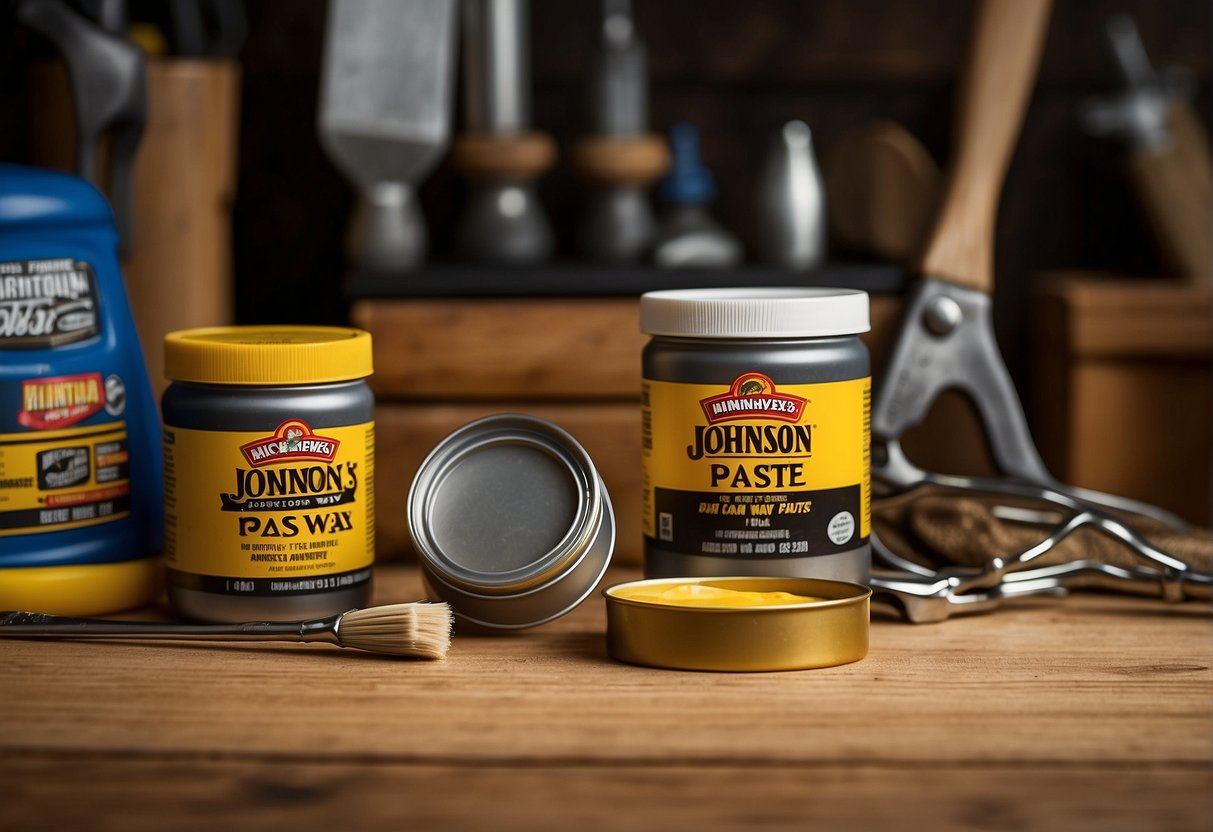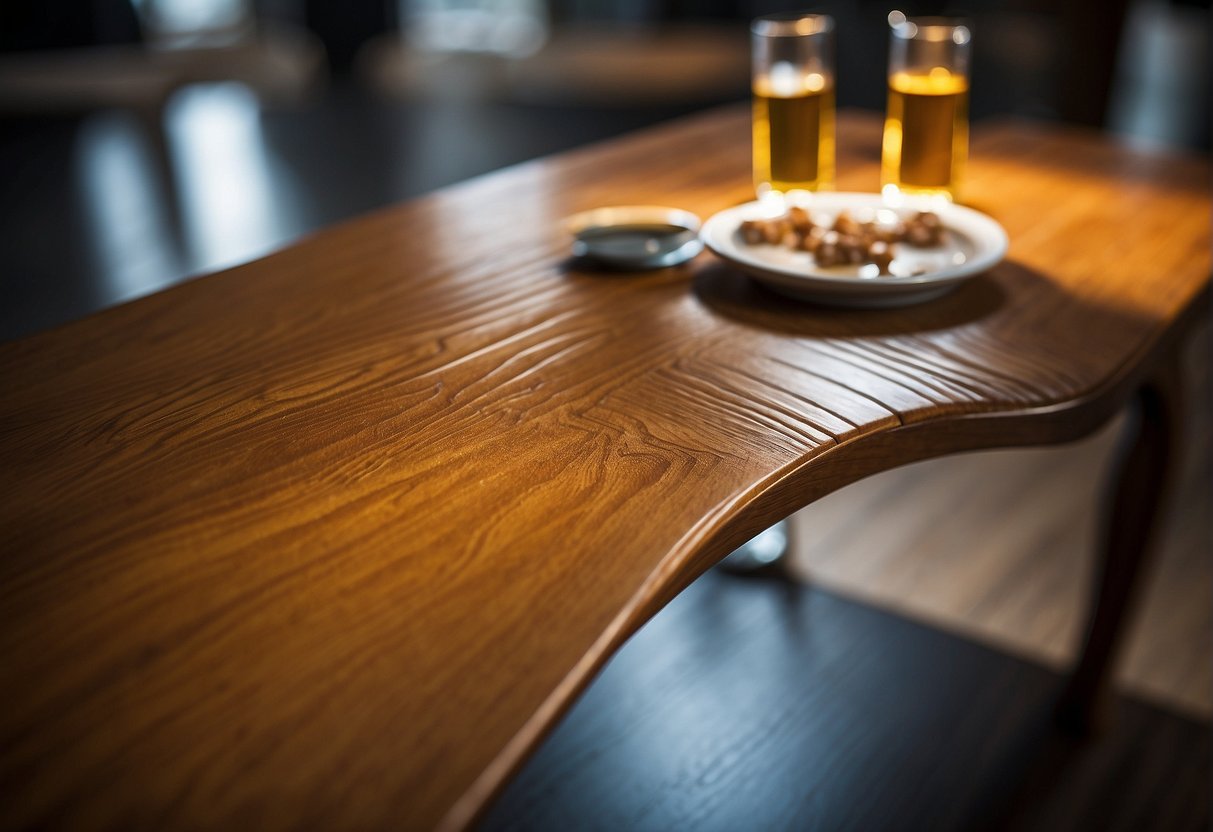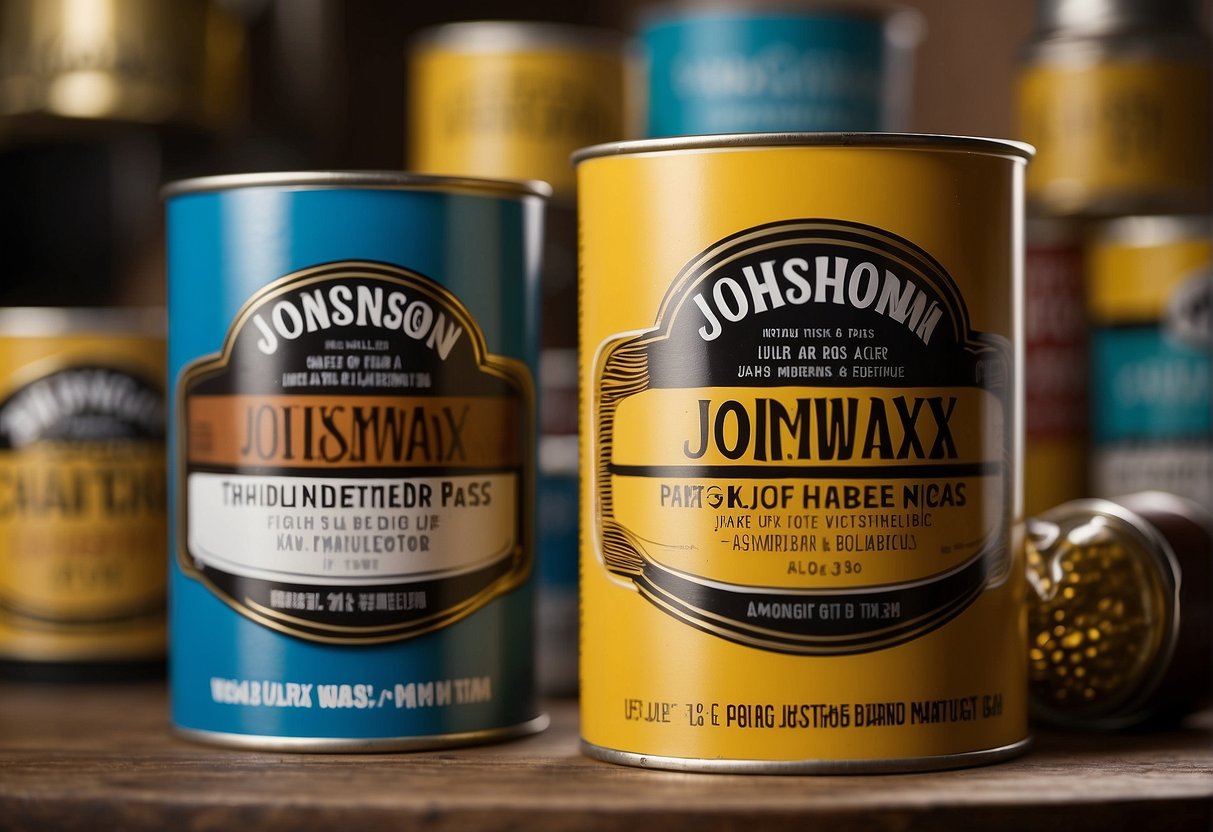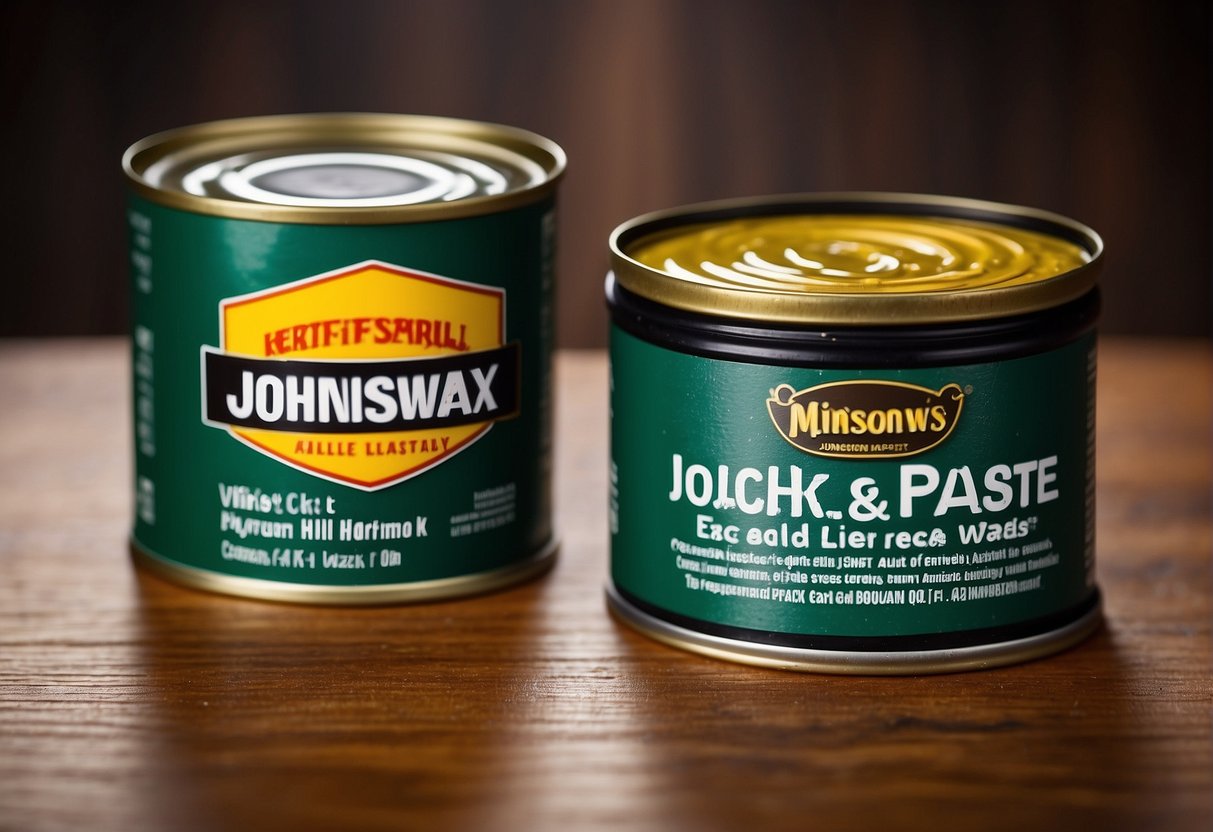I have been using both Johnson Paste Wax and Minwax for years, and I believe that both have their advantages and disadvantages. Johnson Paste Wax is a popular choice among woodworkers because of its affordability and ease of use, while Minwax is known for its durability and ability to withstand wear and tear. Both products have their strengths and weaknesses, and it ultimately comes down to personal preference and the specific project at hand.

When it comes to application and ease of use, Johnson Paste Wax is a breeze to apply and buff out. It goes on smoothly and dries quickly, leaving a nice sheen on the surface. Minwax, on the other hand, requires a bit more effort to apply and buff out, but it is designed to last longer and provide better protection against scratches and other types of damage.
Key Takeaways
- Johnson Paste Wax and Minwax have their own unique strengths and weaknesses.
- Johnson Paste Wax is more affordable and easier to apply, while Minwax is more durable and provides better protection against damage.
- The choice between the two ultimately comes down to personal preference and the specific project at hand.
Overview of Johnson Paste Wax and Minwax

When it comes to protecting and enhancing the look of wood furniture, floors, and other surfaces, Johnson Paste Wax and Minwax are two popular options. Both products are designed to provide a protective layer that repels moisture, stains, and scratches while also enhancing the natural beauty of the wood. In this section, I will provide an overview of Johnson Paste Wax and Minwax, including their composition and ingredients, as well as their brand heritage and reputation.
Composition and Ingredients
Johnson Paste Wax and Minwax are both made from a blend of natural waxes, including carnauba wax, beeswax, and paraffin wax. These waxes are combined with solvents and other additives to create a paste that can be easily applied to wood surfaces. Both products are designed to provide a long-lasting protective layer that repels water, stains, and scratches.
One key difference between Johnson Paste Wax and Minwax is their formula. Johnson Paste Wax contains a higher concentration of natural waxes, which gives it a thicker consistency and a more durable finish. Minwax, on the other hand, contains a lower concentration of waxes, which makes it easier to apply and buff to a high shine.
Brand Heritage and Reputation
Johnson Paste Wax has been around for over 100 years and has a long-standing reputation for quality and durability. The company was founded in 1882 and originally produced a range of household cleaning products. In the 1920s, the company introduced Johnson Paste Wax, which quickly became a popular choice for protecting and shining wood surfaces.
Minwax, on the other hand, is a newer brand that was founded in 1904. The company originally produced a range of wood stains and finishes but later expanded to include paste waxes and other wood care products. Today, Minwax is a well-known brand that is trusted by homeowners and professionals alike for its high-quality products and reliable performance.
In conclusion, both Johnson Paste Wax and Minwax are excellent choices for protecting and enhancing the look of wood surfaces. While Johnson Paste Wax is known for its durability and thicker consistency, Minwax is easier to apply and buff to a high shine. Ultimately, the choice between these two products comes down to personal preference and the specific needs of your project.
Application and Ease of Use
When it comes to comparing Johnson Paste Wax and Minwax, one of the most important factors to consider is the application process and ease of use. In this section, I will discuss the preparation and application process, as well as the time and effort required for both waxes.
Preparation and Application Process
Both Johnson Paste Wax and Minwax require similar preparation and application processes. Before applying either wax, it’s important to ensure that the surface is clean and free of dust and debris. This can be done by wiping the surface down with a clean, dry cloth or by using a vacuum or dusting brush.
Next, apply a thin layer of wax to the surface using a soft cloth or brush. It’s important to apply the wax in the direction of the wood grain to ensure an even finish. Once the wax has been applied, allow it to dry for approximately 10-15 minutes.
After the wax has dried, use a clean, dry cloth to buff the surface in the direction of the wood grain. This will help to remove any excess wax and create a smooth, even finish. For best results, it’s recommended to apply two to three coats of wax, allowing each coat to dry before applying the next.
Time and Effort Required
Both Johnson Paste Wax and Minwax are relatively easy to apply, and the time and effort required for each wax is similar. However, it’s worth noting that Johnson Paste Wax can be slightly more difficult to buff out than Minwax.
Overall, both waxes provide a durable and long-lasting finish that helps to protect and enhance the natural beauty of wood surfaces. When it comes to ease of use, both Johnson Paste Wax and Minwax are excellent options for finishing and waxing power tools, furniture, and other wood surfaces.
Performance and Finish Quality

When it comes to comparing Johnson Paste Wax and Minwax, the performance and finish quality of the products are important factors to consider. In this section, I will discuss the finish and aesthetics as well as the durability and protection provided by each product.
Finish and Aesthetics
Both Johnson Paste Wax and Minwax provide a high-gloss finish that enhances the natural beauty of the wood. However, there are some differences in the aesthetics of the finishes. Johnson Paste Wax tends to produce a slightly warmer and more amber tone, while Minwax produces a cooler and more neutral tone. The difference is subtle, but it can be noticeable on certain types of wood.
In terms of ease of use, both Johnson Paste Wax and Minwax are relatively easy to apply and buff out. However, Johnson Paste Wax can be a bit more difficult to apply evenly due to its thicker consistency. On the other hand, Minwax is easier to apply in thin, even coats.
Durability and Protection
When it comes to durability and protection, Minwax has the edge over Johnson Paste Wax. Minwax is designed to last longer and withstand more wear and tear than Johnson Paste Wax. This is due in part to the fact that Minwax contains carnauba wax, which is a harder and more durable wax than the paraffin wax used in Johnson Paste Wax.
While both products provide some level of protection against scratches and other types of damage, Minwax is better suited for high-traffic areas and furniture that will be subjected to frequent use. Johnson Paste Wax is better suited for items that are more decorative in nature and will not be handled as often.
In conclusion, both Johnson Paste Wax and Minwax provide a high-gloss finish that enhances the natural beauty of the wood. However, Minwax is more durable and provides better protection against wear and tear. Johnson Paste Wax may be a better choice for decorative items, while Minwax is better suited for furniture and other items that will be subjected to frequent use.
Practical Considerations
Price and Budget
When it comes to price, Johnson Paste Wax is typically more affordable than Minwax. A can of Johnson Paste Wax costs around $10, while a can of Minwax Paste Finishing Wax costs around $15. However, keep in mind that the price may vary depending on your location and the store you are buying from. If you are on a tight budget, Johnson Paste Wax may be a better option for you.
Odor and Clean-up
Both Johnson Paste Wax and Minwax have a distinct odor. However, the odor of Johnson Paste Wax is less strong than that of Minwax. If you are sensitive to strong odors, Johnson Paste Wax may be a better option for you. Additionally, both waxes can be easily cleaned up using mineral spirits or turpentine.
Versatility and Use Cases
Both Johnson Paste Wax and Minwax can be used on a variety of surfaces, including wood, metal, and leather. However, it is important to note that Johnson Paste Wax contains silicone, which can cause problems with finishing. If you are planning to apply a finish on top of the wax, it is recommended to use Minwax instead. On the other hand, if you are looking for a lubricant for your tools, Johnson Paste Wax can be a great option as it can help prevent rust and damage.
In summary, when choosing between Johnson Paste Wax and Minwax, practical considerations such as price, odor, and use cases should be taken into account. While Johnson Paste Wax is more affordable and has a less strong odor, it contains silicone and may not be suitable for all finishing applications. Minwax, on the other hand, is more versatile and may be a better option if you plan to apply a finish on top of the wax.
Comparative Analysis

When it comes to choosing between Johnson Paste Wax and Minwax Paste Finishing Wax, both have their own set of advantages and disadvantages. In this section, I will compare the pros and cons of each product.
Pros and Cons of Johnson Paste Wax
Johnson Paste Wax is an inexpensive option when compared to Minwax. It is easy to apply and provides a glossy finish. However, it has a strong smell that can be overwhelming for some users. Additionally, it does not last as long as Minwax and may require frequent reapplication.
Here’s a table summarizing the pros and cons of Johnson Paste Wax:
| Pros | Cons |
|---|---|
| Inexpensive | Strong smell |
| Easy to apply | Requires frequent reapplication |
| Provides a glossy finish | Does not last as long as Minwax |
Pros and Cons of Minwax
Minwax Paste Finishing Wax is a more durable option when compared to Johnson Paste Wax. It is designed to last longer and withstand more wear and tear. It is also easy to use and does not leave a tacky surface. However, it is a bit more expensive than Johnson Paste Wax.
Here’s a table summarizing the pros and cons of Minwax:
| Pros | Cons |
|---|---|
| Durable | More expensive than Johnson Paste Wax |
| Easy to use | – |
| Does not leave a tacky surface | – |
Overall, both Johnson Paste Wax and Minwax Paste Finishing Wax have their own set of advantages and disadvantages. The choice between the two ultimately depends on the user’s preference and needs.
Frequently Asked Questions

What are the differences in application between Johnson Paste Wax and Minwax?
Both Johnson Paste Wax and Minwax Paste Wax are applied in the same way. They are both easy to use and can be applied with a cloth or brush. However, Johnson Paste Wax is known to be more difficult to buff than Minwax Paste Wax. Minwax Paste Wax is also known to offer a more durable finish.
Can both Johnson Paste Wax and Minwax be used on hardwood floors, and if so, how do they compare?
Yes, both Johnson Paste Wax and Minwax Paste Wax can be used on hardwood floors. However, Minwax Paste Wax is more durable and is recommended for high-traffic areas. Johnson Paste Wax is better suited for low-traffic areas.
What are the main ingredients in Minwax Paste Wax, and how do they affect its performance?
The main ingredients in Minwax Paste Wax are carnauba wax, beeswax, and paraffin wax. These ingredients help to create a durable and long-lasting finish. Carnauba wax is known for its water-resistant properties, while beeswax is known for its ability to protect against scratches and scuffs.
For woodworking projects, which wax is preferred by professionals, Johnson Paste Wax or Minwax?
Both Johnson Paste Wax and Minwax Paste Wax are popular among woodworking professionals. However, Minwax Paste Wax is generally preferred due to its durability and long-lasting finish.
What are the best alternatives to Johnson’s Paste Wax for protecting and polishing wood surfaces?
Some of the best alternatives to Johnson’s Paste Wax include Briwax, Howard Feed-N-Wax, and Daddy Van’s All Natural Beeswax Furniture Polish. These products offer similar protection and shine to Johnson’s Paste Wax.
How do Johnson Paste Wax and Minwax affect the maintenance and durability of painted furniture?
Both Johnson Paste Wax and Minwax Paste Wax can be used to protect and maintain painted furniture. However, it is important to note that wax can cause yellowing over time. To avoid this, it is recommended to use a clear wax or a wax that is specifically designed for use on painted surfaces.

Hi, I’m Sal Muller of Tooltrip.com. My DIY experience led me to understand essential power tools for home projects. Tooltrip.com guides enthusiasts and professionals in choosing right tools for any job. I provide concise top tool reviews for easier, efficient DIY.

